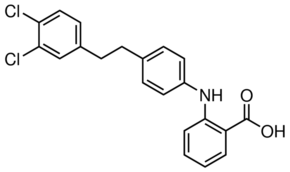All AbMole products are for research use only, cannot be used for human consumption.

For this product's availability, delivery time and price, please email [email protected] directly or click the "Inquiry Now" button below.
PD-118057 is an activator of ether-a-go-go-related (hERG) potassium channel. PD-118057 is a second identified hERG channel activator, a representative in the series of structural analogs; PD-118057 at 10 μM leads to a 111% current increase in rabbit ventricular wedge (in comparison RPR260243 leads to only a 15% increase at the same concentration);PD-118057, unlike RPR260243, does not have a major effect on gating or kinetic properties of this channel. PD-118057prevents and reverses QT interval prolongation; Compounds such as PD-118057 may offer new approach in the treatment of delayed repolarization conditions, which occur in inherited or acquired long QT syndrome and congestive heart failure
| Molecular Weight | 386.27 |
| Formula | C21H17Cl2NO2 |
| CAS Number | 313674-97-4 |
| Solubility (25°C) | DMSO: 9 mg/mL |
| Storage |
Powder -20°C 3 years ; 4°C 2 years In solvent -80°C 6 months ; -20°C 1 month |
[1] Wei Wu, et al. Stoichiometry of altered hERG1 channel gating by small molecule activators
| Related Products |
|---|
| Sulfo-SANPAH
Sulfo-SANPAH is a primary amine-nitrobenzene azide cross-linker. Sulfo-SANPAH is a heterobifunctional crosslinker that contain an amine-reactive N-hydroxysuccinimide (NHS) ester and a photoactivatable nitrophenyl azide. |
| 2-Deoxy-2-fluoro-D-glucose
2-Deoxy-2-fluoro-D-glucose is a radiolabeled glucose analog, which is commonly used in medical imaging techniques such as positron emission tomography (PET) scans. |
| 2-Bromo-4-chlorophenylacetic acid
2-Bromo-4-chlorophenylacetic acid is a biochemical reagent. |
| CPN-351 TFA
CPN-351 TFA is a selective pentapeptide antagonist of human NMUR1 with a pA2 of 7.35. CPN-351 TFA can be used for the research of inflammation. |
| 5-Phenyluracil
5-Phenyluracil is a pyrimidine derivative, a class of heterocyclic aromatic organic compounds crucial in biochemistry. It serves as a synthetic nucleoside analogue, meaning it mimics the structure of naturally occurring nucleosides like uridine. This structural similarity allows it to participate in biochemical reactions, often interfering with normal cellular processes, making it a valuable tool in studying nucleic acid metabolism and developing antiviral and anticancer agents. |
All AbMole products are for research use only, cannot be used for human consumption or veterinary use. We do not provide products or services to individuals. Please comply with the intended use and do not use AbMole products for any other purpose.


Products are for research use only. Not for human use. We do not sell to patients.
© Copyright 2010-2024 AbMole BioScience. All Rights Reserved.
